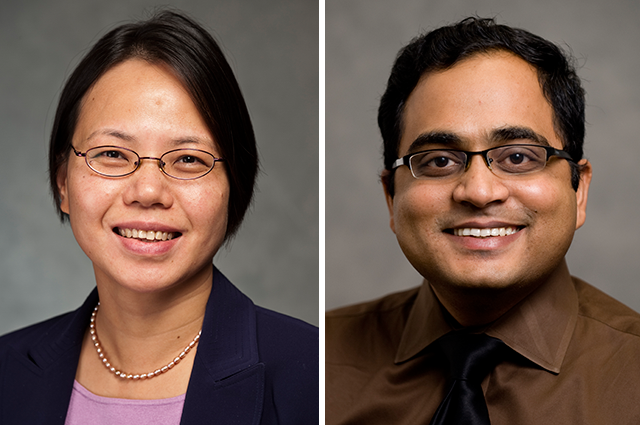Catching waves

With the ever-increasing demand for cellular and wireless communications, electrical engineers are on the lookout for new methods to handle spectrum shortage and to increase capacity. Associate Professor Mai Vu and Professor Sameer Sonkusale recently received a National Science Foundation (NSF) grant to fund their research on overcoming barriers to millimeter wave communication.
The millimeter wave (mmWave) spectra presents a promising alternative to the current frequency range for cellular use. It is able to support both mobile communications and backhaul, or information moving between your cell phone and the cell tower as well as between the towers, at the same time. "Millimeter wave frequencies offer a huge amount of spectrum for communication and is one of the key technologies for the upcoming 5G networks," says Vu.
However, there are several key obstacles to implementing mmWave communications, as the spectra has a number of features that differ from the current frequency range. Vu and Sonkusale’s proposal takes innovative aim at three particular challenges: the need for robust 3D beamforming algorithms, creating new, flexible antennas, and developing an integration plan to bring the two together.
3D beamforming is a signal processing technique traditionally associated with medical uses like imaging in ultrasound, and has only recently been conceived of as having potential applications in communications. mmWave signals reach a receiver from only a few directions, as opposed to the more conventional idea of signals scattering around a receiver. That makes 3D beamforming – which uses both horizontal and vertical angles and allows for greater control of a signal’s direction – a key factor in the potential success of mmWave communications.
However, mmWave signals are vulnerable to blockage and are sensitive to model errors, so Vu and Sonkusale’s proposed robust 3D beamforming algorithms, taking into account several key types of common errors, would be critical in building mmWave communications into a viable option.
The second key piece of the mmWave communications puzzle is infrastructure. Practical antenna arrays need to be lightweight and flat, allowing for electronic scanning without moving parts. There are currently antennas that can scan reliably with high detail over 3D steering angles, but they are too bulky for practical handsets. Sonkusale and Vu propose to develop novel antennas using metamaterials, which would meet the technical needs for mmWave communications while keeping antennas flexible and thin.
Finally, Vu and Sonkusale plan to bring it all together by integrating the algorithms with the antenna design and testing and analyzing their performance.
The research is in its early stages, but the two faculty members are optimistic about its potential impact. "Our algorithm and hardware co-design will help make the realization of a robust, reliable 5G system with flexible handsets," says Vu, and Sonkusale agrees. "Metamaterials enable realization of really thin flexible active antenna arrays for millimeter-wave frequencies," he says. "Our joint hardware/software co-design of a next generation communication system is what is needed to address the unprecedented challenges of working in this spectrum."
This work was supported by the National Science Foundation (#1808912).
Department:
Electrical and Computer Engineering